
Climate Change Impact at Harvard Forest: A New Reality
The impact of climate change is becoming increasingly evident as we witness profound transformations in the ecosystem dynamics at Harvard Forest. Senior ecologist David Orwig highlights striking changes, from the loss of once-dominant hemlock trees to the emergence of more resilient species like black birch due to the warming climate. As researchers delve into environmental studies, it’s clear that not only are weather patterns fluctuating, but the overall health of our forests is shifting dramatically. The long-term environmental research conducted here has captured crucial data, revealing patterns of a warmer and wetter climate that threaten the delicate balance of local ecosystems. Understanding the impact of climate change is more essential than ever as these effects reverberate through our natural world, challenging conservation efforts and reshaping the very essence of our cherished landscapes.
The ramifications of rising global temperatures are increasingly noticeable, particularly in precious natural spaces such as Harvard Forest. Here, ecologists explore ecological shifts, including the decline of hemlock trees and the advent of new flora better suited to the evolving climate conditions. This ongoing scientific inquiry not only illuminates the challenges posed by climate variations but also showcases the resilience of nature as it adapts. As environmental researchers grapple with these pressing issues, it becomes clear that recognizing and addressing the fallout from climate change is vital for preserving ecosystem integrity. In a world where seasons are inconsistent and species are at risk, understanding this phenomenon is crucial for future conservation strategies.
Understanding Climate Change Impacts at Harvard Forest
At Harvard Forest, scientists like David Orwig and Emery Boose are at the forefront of environmental research aimed at understanding how climate change is transforming ecosystems. The historical data gathered over decades allows them to observe significant shifts in species composition and environmental conditions. For instance, the once-dominant hemlocks are facing decline due to the invasive woolly adelgid, a situation that conveys the stark realities of climate change impacts. The adaptability of the forest is put to the test as new species such as black birch begin to prevail, showing that while some trees are lost, others can rise to fill the gap.
The effects of climate change at Harvard Forest are visible not just in the flora but also in the underlying ecosystem resilience. The long-term studies offer insights into how these ecosystems interact with changing climate conditions, showcasing alterations in soil chemistry and nutrient cycling. Evidence suggests that these variations not only impact tree survival but also influence the broader biodiversity within the forest. Scientists are tasked with adapting their research strategies to not only track these changes but also to understand how to promote resilience against further environmental stressors.
The Role of Hemlocks in Ecosystem Dynamics
Hemlocks are not just subservient trees in the Harvard Forest; they play a critical role in maintaining the overall health and dynamics of the forest ecosystem. Their dense canopies moderate temperature extremes and create microclimates essential for various organisms. As highlighted by researchers, the decline of hemlocks due to invasive pests significantly alters these environmental conditions, affecting everything from the soil’s acidity to the availability of habitat for cold-water fish. This cascading impact illustrates why the decline of such a keystone species is alarming in the context of climate change.
Moreover, the transition from hemlocks to black birch fundamentally changes the ecological dynamics of the forest. As these deciduous trees replace the evergreens, shifts in nutrient flow and water usage occur, resulting in various ecological repercussions. These transitions are observed and documented by scientists like Orwig, who emphasize that understanding these dynamics is crucial for fostering a sustainable future within the ecosystem. Monitoring the resilience of remaining hemlocks may yield crucial insights, helping to create strategies for conserving biodiversity amidst the ever-challenging backdrop of climate change.
Ecosystem Resilience Amidst Environmental Change
Ecosystem resilience refers to the ability of an ecosystem to recover from disturbances such as climate change, invasive species, or natural disasters. At the Harvard Forest, researchers are investigating how various species interact with one another and how these interactions can influence resilience. Understanding which species thrive in changing conditions is vital for crafting effective conservation strategies. The research conducted at Harvard Forest becomes increasingly relevant as scientists recognize the importance of fostering diverse and resilient ecosystems capable of withstanding future environmental stress.
The ability of ecosystems to adapt and rebound is a key focus for scientists concerned with environmental research. Observations at Harvard Forest illustrate that while the forest is indeed changing, it also has remarkable capacities for resilience. For instance, the encroachment of black birch has been met with varying degrees of success in terms of ecological integration. By studying how these trees establish themselves in the absence of hemlocks, researchers aim to glean insights into the mechanisms of resilience that could help in future restoration efforts of other threatened environments.
Long-term Environmental Research and Climate Trends
The data amassed from decades of environmental research at Harvard Forest provides a crucial backdrop for understanding long-term climate trends. Scientists have documented significant shifts, such as increased precipitation and warmer winters, confirming phenomena predicted by climate models. This wealth of information allows researchers to identify patterns and make inferences about future ecological conditions. The integration of historical and real-time data creates a robust framework for climate science, underscoring the necessity for continuous monitoring and study.
In addition to supporting a broader understanding of climate change impacts, longstanding research initiatives foster collaboration across various scientific disciplines. The presence of diverse research projects within Harvard Forest not only enhances data collection but also enriches the interpretation of ecological dynamics. As climate change unfolds, the interconnectedness of different species and their responses to changing conditions become apparent, reinforcing the crucial need for interdisciplinary approaches in environmental research.
Invasive Species: A Challenge for Forest Health
Invasive species, such as the woolly adelgid, present significant challenges to forest ecosystems, particularly at Harvard Forest where their impact on hemlock populations is evident. These pests not only disrupt the existing balance within the ecosystem but also exemplify the consequences of climate change on species distribution and survival. The adaptive strategies of invasive species can outpace native species, leading to a decline in biodiversity and altering habitat structures. Understanding these dynamics is crucial for developing effective management strategies to mitigate their effects.
Addressing the threats posed by invasive species requires adaptive and informed management approaches. Harvard Forest researchers actively pursue methods to control the spread of the woolly adelgid while seeking to understand its life cycle and ecological interactions. Collaborative efforts across multiple states have resulted in trials with natural predators aimed at restoring balance to ecosystems that have been thrown off by invasive species. These research initiatives highlight the importance of practical responses to climate change challenges within forest management.
The Impact of Temperature Changes on Forest Ecosystems
Temperature drives many ecological processes, impacting everything from species migration patterns to reproductive cycles. At Harvard Forest, scientists have observed clear evidence of temperature changes impacting the forest’s health. Warming winters lead to significant shifts in snowpack duration, and certain tree species begin to flourish while others face decline. Such changes alter not only the species composition but also the ecosystem functions, necessitating a deeper understanding of how these temperature-related changes affect global forest systems.
The implications of fluctuating temperatures are profound for forest managers and ecologists. As temperatures rise, so too do the challenges for maintaining biodiversity and ecosystem services. Research efforts at Harvard Forest concentrate on modeling how species might migrate and adapt to these changes over time. By identifying vulnerable species and potential refuges within the landscape, researchers strive to enhance forest resilience in the face of inevitable climate change, with strategic interventions that can aid in their survival amidst rising temperatures.
Understanding the Community’s Connection to Harvard Forest
The community surrounding Harvard Forest plays a pivotal role in the ongoing research and conservation efforts. Local stakeholders, including residents, students, and volunteers, contribute to the sustainability of the forest by participating in educational programs and citizen science initiatives. This community connection fosters a deeper appreciation for the natural world and enhances the mission to protect and preserve the unique ecosystems within Harvard Forest. As climate change impacts unfold, the involvement of community members is essential for driving local conservation efforts.
Educational outreach efforts at Harvard Forest aim to engage the public in meaningful conversations about climate change and its impact on local ecosystems. By bringing awareness to the shifts occurring within the forest, researchers inspire community involvement and action against climate challenges. The combined efforts of scientists and local residents offer a hopeful perspective, generating innate curiosity and a commitment to environmental stewardship that can help ensure the future resilience of the forest and its diverse flora and fauna.
Shifting Baselines and Future Generations
The concept of shifting baselines describes how individuals’ perceptions of normality change over generations, particularly in terms of environmental conditions. For many younger individuals who grow up only experiencing altered environments, the understanding of what a healthy ecosystem entails may be fundamentally different compared to older generations. At Harvard Forest, this phenomenon is addressed through educational programs that highlight historical climate conditions alongside current changes, fostering awareness and appreciation for the nuances that shape local ecology.
As climate change continues to reshape landscapes, the concern grows that future generations might lack the necessary context to appreciate the importance of intact ecosystems that once thrived. By instilling values of conservation, scientists and educators at Harvard Forest aim to inspire a sense of responsibility among youth. This investment in education will help foster a new generation of advocates for maintaining biodiversity, with a recognition of how invasive species and climate change impact their environment and community.
Future Directions in Climate Resilience Research
As the effects of climate change become increasingly pronounced, the need for ongoing climate resilience research is paramount. The work at Harvard Forest highlights innovative methods for understanding these changes, such as the use of experimental plots designed to simulate warming and assess impacts on biodiversity. These real-time experiments serve as a platform for developing and testing theoretical models that predict how forest ecosystems might respond under future climate scenarios. Such research efforts are critical in paving the way toward informed forest management practices that promote resilience.
Moreover, the focus on adaptive strategies to enhance forest resilience in response to climate change is gaining momentum. Collaborations between scientists and policymakers take center stage in shaping forward-thinking policies that will guide sustainable land management. By fostering a deeper understanding of ecosystem interactions, the ongoing research at Harvard Forest equips stakeholders with the necessary tools to address the multifaceted challenges posed by climate change, ensuring the vitality of forest ecosystems now and for future generations.
Frequently Asked Questions
What is the impact of climate change on forest ecosystems like Harvard Forest?
The impact of climate change on forest ecosystems such as Harvard Forest is profound, characterized by warmer winters, altered precipitation patterns, and the decline of key tree species like hemlocks. Over time, invasive pests thrive as colder winters become less frequent, leading to ecological shifts that replace hemlocks with species like black birches. This transition affects the overall ecosystem resilience and alters the microenvironments within the forest.
How does the decline of hemlocks due to climate change affect Harvard Forest?
The decline of hemlocks in Harvard Forest due to climate change impacts the forest’s structure, ecology, and biodiversity. Hemlocks play a critical role in regulating soil chemistry and temperature, thus supporting various cold-water species. As these trees are replaced by species like black birches, changes occur in nutrient cycling and habitat conditions, which may affect the ecosystem’s resilience and the species that depend on this environment.
What research is being done at Harvard Forest regarding climate change impacts?
Harvard Forest conducts extensive environmental research focused on climate change impacts, with over 100 projects examining various aspects of ecology and climate interaction. This includes studying shifts in species distributions, the effects of invasive species like woolly adelgid on hemlocks, and monitoring long-term trends in temperature and precipitation that contribute to ecosystem changes in the forest.
How are invasive pests related to climate change in Harvard Forest?
Invasive pests, particularly the woolly adelgid, have become more prevalent in Harvard Forest due to climate change. Milder winter temperatures have allowed these pests to thrive and move northward, leading to increased hemlock decline. This phenomenon illustrates how climate change can facilitate the spread of invasive species, further impacting forest health and ecosystem resilience.
What role does Harvard Forest play in understanding climate change?
Harvard Forest plays a crucial role in understanding climate change by serving as a living laboratory where scientists study long-term ecological data, including temperature and precipitation records dating back to the 1960s. This data helps researchers identify climate trends and their impacts on forest ecosystems, enhancing our knowledge of environmental changes and informing conservation strategies.
How does climate change affect the microenvironments within Harvard Forest?
Climate change alters the microenvironments within Harvard Forest by modifying the composition of tree species and thus affecting soil chemistry, moisture levels, and light availability. As hemlocks decline and are replaced by deciduous species like black birches, changes occur in nutrient recycling, temperature regulation, and habitat conditions, impacting the forest’s overall resilience and biodiversity.
What are the long-term observations of climate change impacts at Harvard Forest?
Long-term observations at Harvard Forest reveal significant trends due to climate change, including increased average temperatures and altered precipitation patterns. Researchers have noted shifts in tree populations, species behavior, and disturbances caused by invasive species, all of which highlight the dramatic ecological changes arising from climate variability. These insights are critical for understanding future impacts and ecosystem management.
| Key Points |
|---|
| Harvard Forest serves as a living laboratory for studying the immediate impacts of climate change. |
| Researchers document observable changes in forest ecology, including tree species, understory light, and soil composition. |
| The long-term data available enables scientists to identify trends of warming and increased precipitation since the 1960s. |
| Invasive species, like the woolly adelgid, threaten local hemlock populations, leading to shifts in forest composition. |
| Changing weather patterns, such as mind winds and variable snowpack, directly affect traditional winter sports in the area. |
| Resilience of ecosystems is highlighted despite ongoing transformations due to climate change. |
| Personal experiences of researchers emphasize the deep emotional connection to the changing landscape. |
Summary
Climate change impact is a pressing issue, vividly evidenced in places like Harvard Forest, where researchers observe significant transformations in ecology and weather patterns. As scientists meticulously document changes in species, tree health, and climate data, it becomes clear that the forest is not just a backdrop but a dynamic participant in the climate narrative. The transformation of tree populations, like the decline of the hemlocks due to invasive pests, serves as a poignant reminder of the adaptive and sometimes painful shifts that ecosystems undergo. We are urged to recognize the stories behind these changes, as they highlight the urgency of addressing climate change and protecting fragile environments for future generations.









